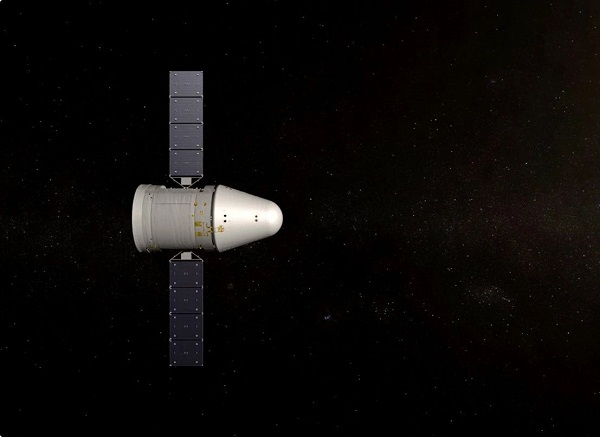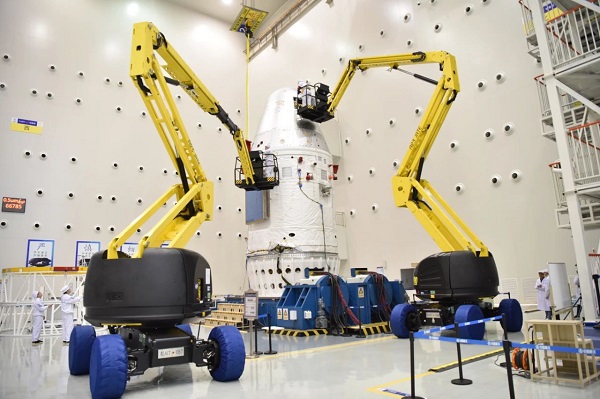China's next-generation space capsule aces orbital maneuvers during test flight
It returns to Earth Friday (May 7).
China's next-generation spacecraft for astronauts has aced a series of maneuvers in orbit two days into its maiden voyage.
The uncrewed space capsule launched on China's first Long March 5B rocket Tuesday (May 5). The rocket is an upgraded version of China's heavy-lift Long March 5 and will be used to launch modules for China's planned space station, officials with the China National Space Administration (CNSA) have said. As of Thursday (May 7), the new space capsule had completed six of seven maneuvers to adjust its orbit, according to state media reports.
"So far, our spacecraft has been in very good condition," Dang Rong, a member of the mission's flight control expert group at the China Academy of Space Technology, said in a CCTV video. "Later, we are actually looking at the test of the return technology."
Video: China's new crew capsule for astronauts explained
Related: How China's space station will work (infographic)



The solar-powered space capsule, which apparently does not yet have an official name, is the successor to China's Shenzhou space capsule, which has launched all six of the country's crewed spaceflights. Those missions began with the launch of astronaut Yang Liwei on the Shenzhou 5 in October 2003 and culminated with the October 2016 launch of two astronauts on the Shenzhou 11 flight to the country's Tiangong-2 space laboratory. Tiangong-2 fell to Earth in 2019 in a planned deorbit maneuver that dumped the spacecraft into the Pacific Ocean.
China's new crew capsule is expected to be the country's go-to spacecraft for future astronaut flights to a planned space station, and could eventually make deep-space missions to the moon. The spacecraft can carry up to seven astronauts and has been likened to a "space bus" with reusable "multi-mission" components, according to a translated description from the China Academy of Space Technology.
The new space capsule is expected to return to Earth on Friday (May 8) using a heat shield and parachutes to make its descent toward a safe landing in the Inner Mongolia Autonomous Region of northern China, according to China's state-run Xinhua news agency.
Get the Space.com Newsletter
Breaking space news, the latest updates on rocket launches, skywatching events and more!
In addition to the space capsule, the Long March 5B rocket also carried a prototype inflatable cargo reentry system that was tested during the mission, according to a mission description.
- Latest news about China's space program
- Russia and China are teaming up to explore the moon
- Photos from the moon's far side! China's Chang'e 4 lunar landing in pictures
Email Tariq Malik at tmalik@space.com or follow him @tariqjmalik. Follow us @Spacedotcom, Facebook and Instagram.
OFFER: Save 45% on 'All About Space' 'How it Works' and 'All About History'!
For a limited time, you can take out a digital subscription to any of our best-selling science magazines for just $2.38 per month, or 45% off the standard price for the first three months.
Join our Space Forums to keep talking space on the latest missions, night sky and more! And if you have a news tip, correction or comment, let us know at: community@space.com.

Tariq is the Editor-in-Chief of Space.com and joined the team in 2001, first as an intern and staff writer, and later as an editor. He covers human spaceflight, exploration and space science, as well as skywatching and entertainment. He became Space.com's Managing Editor in 2009 and Editor-in-Chief in 2019. Before joining Space.com, Tariq was a staff reporter for The Los Angeles Times covering education and city beats in La Habra, Fullerton and Huntington Beach. In October 2022, Tariq received the Harry Kolcum Award for excellence in space reporting from the National Space Club Florida Committee. He is also an Eagle Scout (yes, he has the Space Exploration merit badge) and went to Space Camp four times as a kid and a fifth time as an adult. He has journalism degrees from the University of Southern California and New York University. You can find Tariq at Space.com and as the co-host to the This Week In Space podcast with space historian Rod Pyle on the TWiT network. To see his latest project, you can follow Tariq on Twitter @tariqjmalik.










